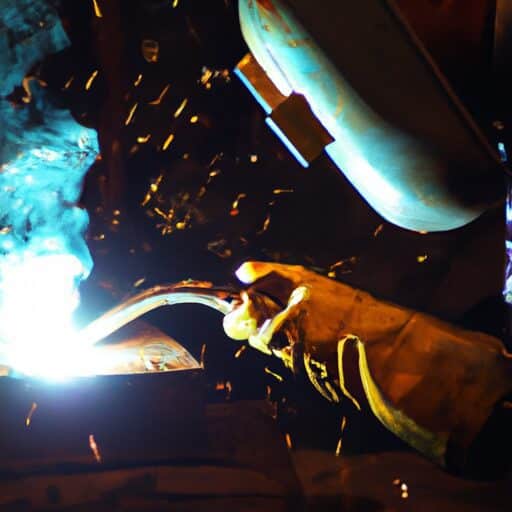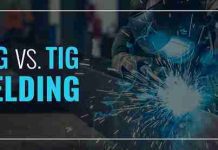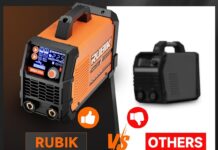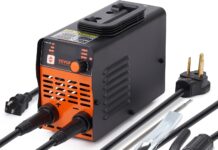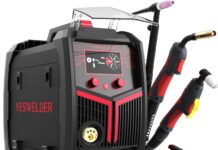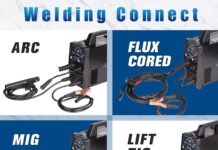Looking to learn the art of welding cast iron? Look no further! In this article, we will guide you through the step-by-step process of welding this delicate material with ease. Whether you’re a seasoned welder or a novice looking to expand your skills, we’ve got you covered. So, grab your welding gear and let’s dive right in to discover the secrets of welding cast iron like a pro!
Choosing the Right Welding Process
When it comes to welding cast iron, it is essential to choose the right welding process. Cast iron has unique properties and characteristics that require specific welding techniques. By understanding the properties of cast iron, considering the type of cast iron, and identifying its thickness, we can select the most appropriate welding process.
Understanding the Properties of Cast Iron
Cast iron is a strong and dense material that is susceptible to cracking during the welding process. It has a high carbon content, which makes it brittle and prone to forming cracks. Additionally, cast iron has a low melting point compared to other metals, making it more challenging to weld. Understanding these properties is crucial in selecting the appropriate welding process.
Considering the Type of Cast Iron
There are different types of cast iron, each with its own unique composition and properties. The most common types are gray cast iron, ductile cast iron, malleable cast iron, and white cast iron. Each type requires different welding techniques and filler materials. Therefore, it is important to consider the specific type of cast iron being welded.
Identifying the Thickness of the Cast Iron
The thickness of the cast iron also plays a significant role in the choice of welding process. Thicker sections require higher heat inputs and longer preheating times to prevent cracking. Thinner sections, on the other hand, may require different welding techniques to avoid overheating and distortion. By accurately identifying the thickness of the cast iron, we can determine the appropriate welding process.
Researching the Welding Processes for Cast Iron
Once we have a clear understanding of the properties, type, and thickness of the cast iron, it is essential to research the available welding processes for cast iron. Some common welding processes used for cast iron include stick welding (SMAW), oxy-acetylene welding, TIG welding (GTAW), and MIG welding (GMAW). Each process has its advantages and disadvantages, and thorough research will help us make an informed decision.
Preparing the Cast Iron
Proper preparation of the cast iron before welding is crucial to ensure a successful weld. Several steps need to be followed in this preparation process.
Cleaning the Surface
Before welding, the surface of the cast iron must be thoroughly cleaned to remove any dirt, grease, or rust. This can be done using appropriate cleaning agents and tools such as wire brushes or sandpaper. Cleaning the surface ensures better adhesion and reduces the chances of porosity or inclusions in the weld.
Removing Any Coatings or Paint
If the cast iron has any coatings or paint, it is important to remove them before welding. Coatings and paint can create unwanted fumes, affect the weld quality, and lead to contamination. Removing these coatings ensures a clean surface for welding.
Removing Any Cracks or Defects
If the cast iron has any cracks or defects, they need to be addressed before welding. Cast iron can be prone to cracks, and welding over them without proper repair can result in further cracking. Cracks and defects should be carefully ground, filled, or repaired using suitable techniques to ensure a structurally sound weld.
Preheating the Cast Iron
Preheating the cast iron before welding is critical to minimize the chances of cracking. Cast iron has a high thermal expansion coefficient, and preheating helps reduce the temperature gradient between the cast iron and the weld metal. Preheating should be done gradually and to the appropriate temperature based on the thickness and type of cast iron being welded.
Selecting the Correct Filler Material
Choosing the right filler material for welding cast iron is essential to ensure a strong and durable weld. Several factors need to be considered in this selection process.
Choosing the Right Filler Material for Cast Iron
The filler material used for welding cast iron should match its composition and properties. Common filler materials for cast iron welding include nickel-based electrodes or rods, as they provide good strength and ductility. It is important to consult welding experts or refer to welding guidelines to select the most appropriate filler material.
Considering the Desired Weld Thickness
The desired weld thickness also influences the choice of filler material. If a thicker weld is required, a larger diameter filler material may be needed. Conversely, thinner welds may require finer filler materials. Matching the filler material to the desired weld thickness ensures proper penetration and strength.
Matching the Filler Material to the Base Metal
It is crucial to match the filler material to the base metal being welded. The filler material should have similar properties to the cast iron to achieve a compatible weld. The melting point and chemical composition of the filler material should align with the cast iron to avoid any issues during the welding process.
Evaluating the Strength Requirements
The strength requirements of the weld should also be taken into consideration when selecting the filler material. If the cast iron is expected to undergo high stress or load-bearing applications, a filler material with higher strength properties should be chosen. Assessing the strength requirements helps determine the suitability of the filler material.
Setting up the Welding Equipment
Proper setup of the welding equipment is essential for a successful cast iron weld. Several key considerations should be taken into account during this setup process.
Choosing the Right Welding Machine
Selecting the right welding machine is vital for welding cast iron. The machine should have the necessary control features to adjust heat inputs, amperage settings, and electrode compatibility. It is recommended to use machines specifically designed for welding cast iron or consult with welding professionals to ensure the machine’s suitability.
Selecting the Appropriate Electrode
Choosing the appropriate electrode is crucial for a successful cast iron weld. Electrodes specifically designed for welding cast iron, such as nickel-based electrodes, are commonly used. The electrode should have good wetting properties and provide excellent crack resistance. Consideration should also be given to the electrode diameter, which should match the desired weld thickness.
Using the Correct Amperage Settings
Setting the correct amperage is important to achieve proper fusion and penetration during welding. The amperage settings should be in line with the electrode and base metal being welded. Too high or too low amperage can negatively impact the quality of the weld. Consulting welding tables or experts can help determine the appropriate amperage settings.
Ensuring Proper Grounding
Proper grounding is crucial to ensure electrical safety and achieve good weld quality. The welding machine should be grounded correctly, and the workpiece should be securely clamped to prevent any electrical shocks or disturbances. Without proper grounding, the welding process may be compromised, leading to poor weld quality.
Implementing the Welding Technique
The welding technique used to weld cast iron plays a significant role in the strength and quality of the final weld. Several important techniques should be employed during the welding process.
Using Preheat Techniques
Preheating the cast iron is often necessary to minimize the risk of cracking. Gradual preheating can be done using a torch or a furnace to bring the cast iron to the desired temperature range. Preheating helps counteract the high thermal expansion coefficient of cast iron and improves the weld’s integrity.
Creating V-Groove or U-Groove Joints
Creating V-groove or U-groove joints is commonly practiced in welding cast iron. These types of joints provide better mechanical strength and allow better access for the filler material. Properly preparing these joints by grinding or machining ensures proper fit-up and better welding outcomes.
Implementing Tack Welds
Tack welds are small, temporary welds used to hold the workpieces in place before the final welding process. Tack welds help prevent distortion and misalignment during welding. They also allow for adjustments before committing to the final weld, ensuring better precision and accuracy.
Applying the Welding Technique
During the welding process, it is important to maintain a stable arc and control the heat input. The welding technique should be practiced consistently, ensuring proper fusion and penetration. The travel speed and angle of the electrode, as well as the deposition rate, should be carefully controlled to achieve the desired bead size and strength.
Managing the Welding Process
Managing the welding process effectively ensures a successful outcome. Various factors should be considered throughout the welding process.
Controlling the Heat Input
Controlling the heat input is crucial to prevent overheating or underheating during the welding process. Proper adjustment of the amperage, travel speed, and preheating temperature helps maintain the optimal heat input. Heat control is particularly critical when welding cast iron due to its susceptibility to cracking.
Maintaining a Stable Arc
A stable arc is essential for achieving consistent and high-quality welds. Proper electrode manipulation, adequate amperage settings, and good grounding are factors that contribute to maintaining a stable arc. A stable arc ensures better control over the welding process and improves the overall weld’s integrity.
Avoiding Overheating
Overheating the cast iron can result in cracking, distortion, and weakening of the weld. Careful monitoring of the heat input, proper preheating, and utilizing appropriate welding techniques help prevent overheating. Avoiding overheating is crucial for maintaining the cast iron’s structural integrity and ensuring a strong weld.
Applying the Welding Comparatively
Applying the welding process comparatively refers to ensuring consistency throughout the weld. The bead size, direction, and deposition rate should be uniform to achieve a visually appealing and structurally sound weld. Consistency in welding technique helps create a reliable and durable cast iron weld.
Post-Welding Procedures
After completing the welding process, several post-welding procedures should be followed to ensure the weld’s integrity and longevity.
Peening the Weld
Peening the weld involves striking the weld area with a peening hammer while it is still hot. This process helps relieve stress and redistributes the excess material, enhancing the weld’s strength and resistance to cracking. Peening should be done carefully to avoid damaging the weld.
Stress Relieving the Weld
Stress relieving is a heat treatment process that helps reduce residual stresses in the weld. It involves heating the entire welded piece to a specified temperature below the critical point, holding it at that temperature, and then gradually cooling it. Stress relieving enhances the stability and strength of the cast iron weld.
Cooling the Weld Gradually
Proper cooling of the weld is essential to prevent thermal stress and cracking. Once the welding is complete, the cast iron should be allowed to cool gradually in still air. Rapid cooling, such as quenching in water, should be avoided as it can introduce additional stress and compromise the weld’s integrity.
Performing Grinding or Machining if Needed
After the weld has cooled, it may be necessary to perform grinding or machining to achieve the desired surface finish or remove any excess material. Care should be taken to avoid removing excessive material that could compromise the strength or compromise the weld’s integrity. Grinding or machining should be done with precision and care.
Addressing Common Challenges
When welding cast iron, certain challenges may arise that need to be addressed for a successful weld. Several common challenges and their solutions are outlined below.
Dealing with Shrinkage Cracks
Shrinkage cracks can occur in cast iron due to its high carbon content and thermal contraction during cooling. To address shrinkage cracks, preheating and controlling the cooling process become crucial. Ensuring the cast iron cools gradually and uniformly can help minimize the formation of shrinkage cracks.
Repairing Porosity or Inclusions
Porosity or inclusions can occur in the weld due to contamination or improper welding techniques. To repair porosity or inclusions, the affected areas should be properly cleaned and ground. Following that, additional filler material can be added using appropriate welding techniques, ensuring proper fusion with the base metal.
Managing Thermal Expansion Issues
Thermal expansion is a common challenge when welding cast iron due to its high coefficient of thermal expansion. To manage thermal expansion, preheating the cast iron is essential to reduce the temperature gradient between the base metal and the welding material. Proper preheating helps minimize the risk of distortion and promotes better fusion.
Avoiding Distortion or Warping
Distortion or warping can occur during the welding process due to the high heat input and thermal expansion. To avoid distortion or warping, it is important to carefully manage the heat input, control the welding technique, and use suitable clamping or fixturing methods to maintain the proper alignment of the cast iron. Ensuring uniform heat distribution and appropriate cooling techniques also help in minimizing distortion.
Safety Measures
Welding cast iron requires strict adherence to safety measures to protect the welder and ensure a safe working environment. Here are some essential safety precautions to follow.
Using Appropriate Personal Protective Equipment
Welders should always wear appropriate personal protective equipment (PPE) when welding cast iron. This includes a welding helmet with a properly shaded lens, flame-resistant clothing, welding gloves, and safety boots. PPE protects against harmful UV radiation, sparks, and potential injury.
Working in a Well-Ventilated Area
Welding generates fumes, gases, and smoke that can be harmful if inhaled. It is important to work in a well-ventilated area to ensure proper air circulation and minimize exposure to hazardous substances. If working indoors, additional ventilation systems or exhaust fans may need to be used.
Ensuring Proper Fire Safety Precautions
Welding involves the use of high heat, sparks, and open flames, making fire safety precautions paramount. The work area should be clear of flammable materials, and fire extinguishers should be readily accessible. Proper training on fire safety and a fire watch during and after welding should also be implemented.
Checking for Flammable Surroundings
Before beginning the welding process, it is essential to check for flammable surroundings. Gasoline, oil, grease, and other flammable substances should be removed or stored away from the welding area. Ensuring a safe and non-flammable environment minimizes the risk of fire or explosions.
When to Seek Professional Help
While welding cast iron can be done by experienced welders, there are certain situations where it may be more beneficial to seek professional assistance.
Evaluating the Complexity of the Project
If the welding project involving cast iron is complex and requires specialized knowledge and equipment, it may be best to enlist the help of professional welders. They have the expertise and experience to handle intricate welds and ensure proper execution.
Considering the Importance of the Weld’s Strength
In applications where the weld’s strength is critical, such as load-bearing structures or high-stress components, it is advisable to consult professional welders. They can ensure the weld’s integrity and perform necessary tests to validate its strength.
Assessing the Availability of Welding Equipment
Welding cast iron may require specific equipment or tools that may not be readily available to every individual. If the necessary welding equipment is not accessible, it may be more practical to engage professional welders who have the required equipment for welding cast iron.
Reviewing Your Welding Skills and Experience
Honest self-assessment of welding skills and experience is important when considering welding cast iron. If one is not confident in their ability to weld cast iron or lacks experience in working with this material, it is advisable to seek professional help to ensure a successful outcome.
In conclusion, welding cast iron requires careful consideration of various factors, including choosing the right welding process, preparing the cast iron, selecting the correct filler material, setting up the welding equipment correctly, implementing the appropriate welding technique, managing the welding process, following post-welding procedures, addressing common challenges, adhering to safety measures, and knowing when to seek professional help. By following these guidelines and practices, one can achieve strong and durable welds on cast iron and ensure the integrity of the finished product.


